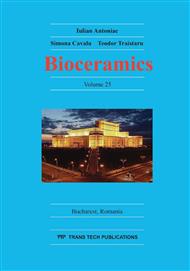p.245
p.249
p.255
p.263
p.269
p.275
p.282
p.287
p.293
Bioactive Ti Metal with Ca-Enriched Surface Layer Able to Release Sr Ions
Abstract:
Bioactive Ti metal able to release Sr ions was prepared by chemical and heat treatments of Ti metal. Ti metal was initially soaked in 5M NaOH solution to form sodium hydrogen titanate. It was soaked in a mixed solution of CaCl2 and SrCl2 to replace its Na ions with Ca and Sr ions at a given range from 0.18 to 1.62 in Sr/Ca ratio. When it was heat-treated at 600 oC, it formed Sr-containing calcium titanate (SrCT) and rutile. The apatite formation in SBF of the treated metal was low, but increased markedly by subsequently soaking the metal in 1 M SrCl2 solution at 80 oC. Thus, the treated metal gradually released Sr ions into phosphate-buffered saline up to 0.9 ppm. It is expected that the Ti metal formed with the bioactive SrCT layer could release Sr ions in a living body to promote bone formation, and bond to a living bone through an apatite.
Info:
Periodical:
Pages:
269-274
Citation:
Online since:
November 2013
Authors:
Price:
Сopyright:
© 2014 Trans Tech Publications Ltd. All Rights Reserved
Share:
Citation:


